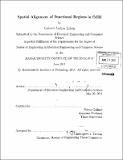| dc.contributor.advisor | Polina Golland. | en_US |
| dc.contributor.author | Tobón, Gabriel Andres | en_US |
| dc.contributor.other | Massachusetts Institute of Technology. Dept. of Electrical Engineering and Computer Science. | en_US |
| dc.date.accessioned | 2011-11-01T19:47:37Z | |
| dc.date.available | 2011-11-01T19:47:37Z | |
| dc.date.copyright | 2011 | en_US |
| dc.date.issued | 2011 | en_US |
| dc.identifier.uri | http://hdl.handle.net/1721.1/66810 | |
| dc.description | Thesis (M. Eng.)--Massachusetts Institute of Technology, Dept. of Electrical Engineering and Computer Science, 2011. | en_US |
| dc.description | Cataloged from PDF version of thesis. | en_US |
| dc.description | Includes bibliographical references (p. 49-50). | en_US |
| dc.description.abstract | An essential step for discovering a common structure in brain activation regions from multi-subject fMRI data is the ability to find spatial correspondences across subjects. This has proven to be a challenging problem due to the lack of a ground truth and variability in anatomical brain structure, functional activation, and spatial locations of functional regions. Standard methods rely on the correspondences given by anatomical registration to a common space, but fail to account for spatial variability of the functional regions relative to anatomy. We develop a clustering method that relies on the alignment of both the anatomical structure and the functional landmarks. The method is shown to improve over standard group analysis techniques that rely on anatomical alignment only. The validation of our method confirms that peaks of activation exhibit consistent spatial structure. Furthermore, our work creates a framework for future testing of different metrics for similarity of brain activation regions across subjects. | en_US |
| dc.description.statementofresponsibility | by Gabriel Andres Tobón. | en_US |
| dc.format.extent | 50 p. | en_US |
| dc.language.iso | eng | en_US |
| dc.publisher | Massachusetts Institute of Technology | en_US |
| dc.rights | M.I.T. theses are protected by
copyright. They may be viewed from this source for any purpose, but
reproduction or distribution in any format is prohibited without written
permission. See provided URL for inquiries about permission. | en_US |
| dc.rights.uri | http://dspace.mit.edu/handle/1721.1/7582 | en_US |
| dc.subject | Electrical Engineering and Computer Science. | en_US |
| dc.title | Spatial alignment of functional regions in fMRI | en_US |
| dc.title.alternative | Spatial modeling of functional regions of interest in fMRI group analysis | en_US |
| dc.type | Thesis | en_US |
| dc.description.degree | M.Eng. | en_US |
| dc.contributor.department | Massachusetts Institute of Technology. Department of Electrical Engineering and Computer Science | |
| dc.identifier.oclc | 757169317 | en_US |
